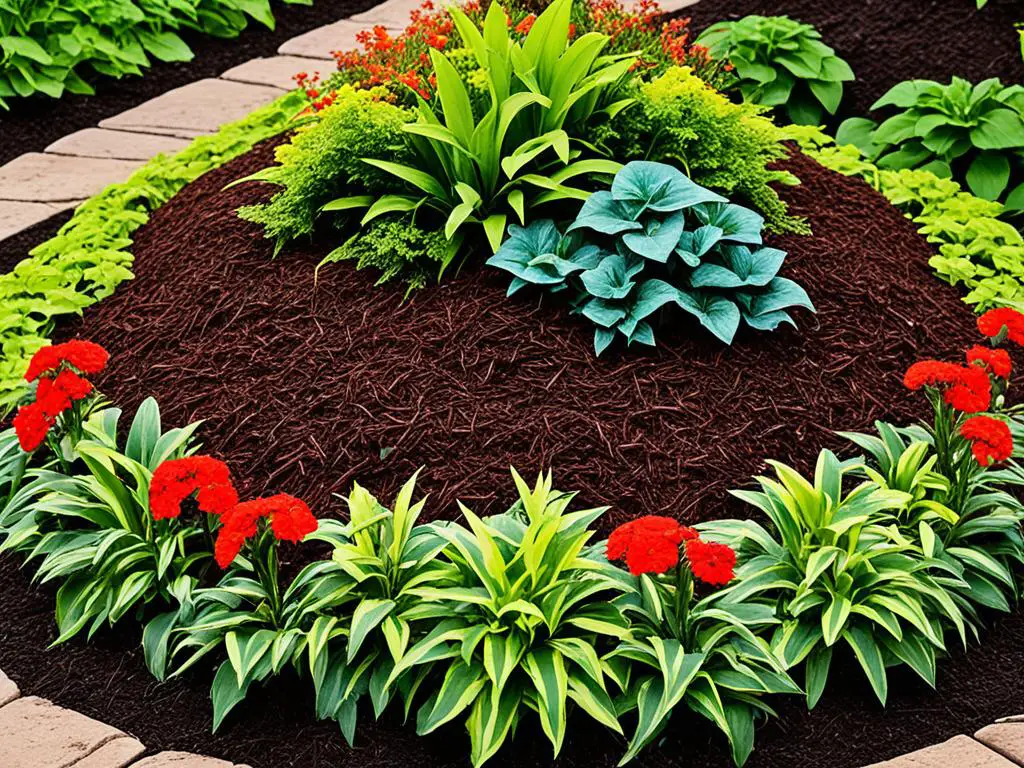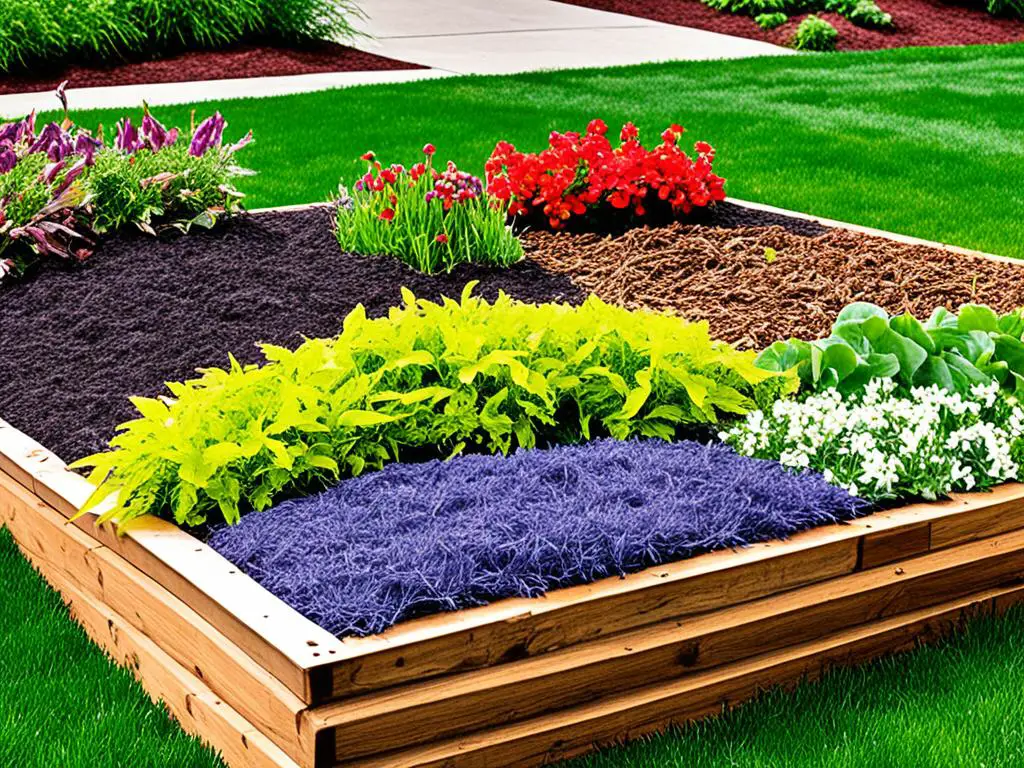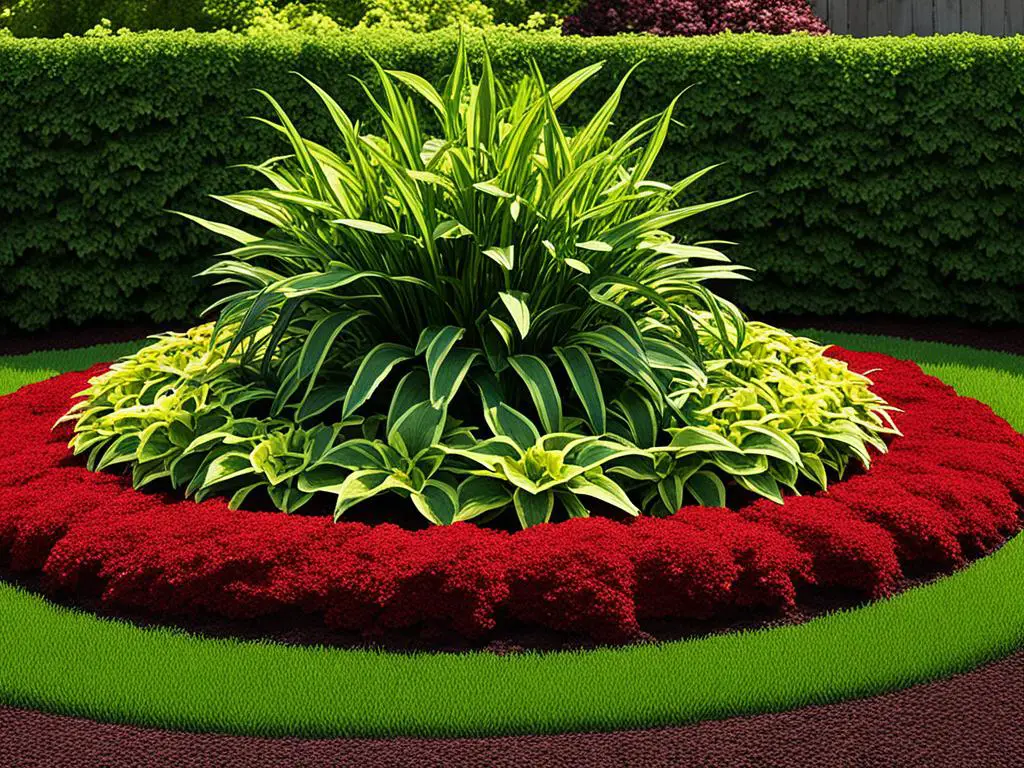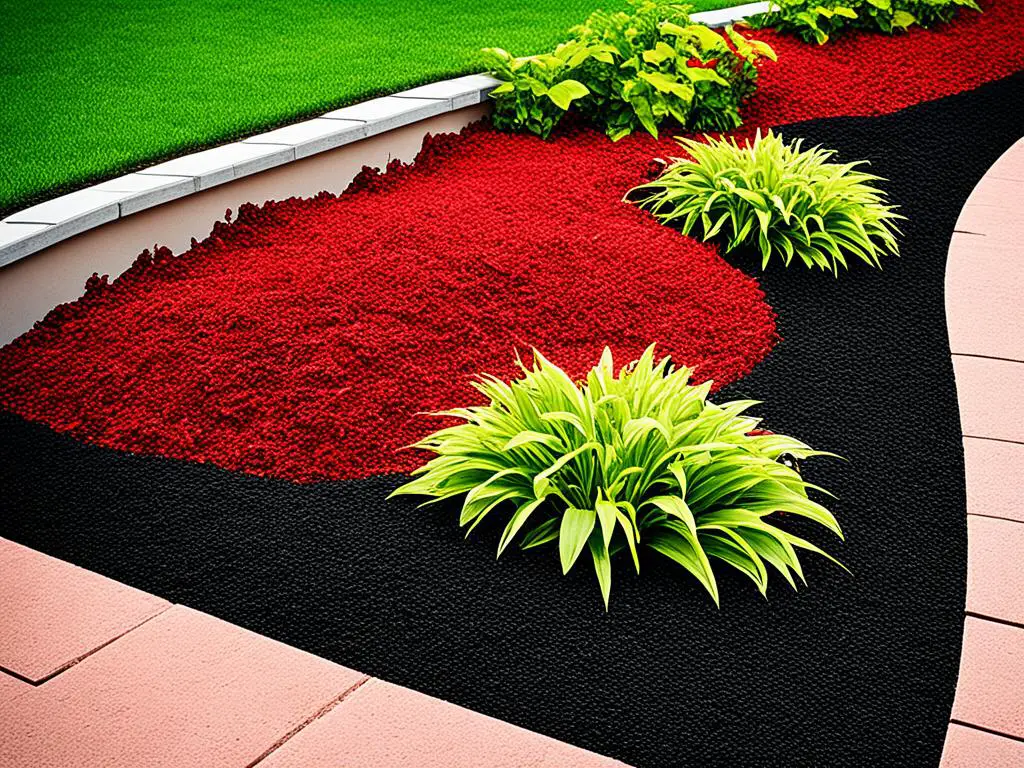Mulch is a crucial component of any well-maintained garden. Not only does it enhance the overall aesthetics of your outdoor space, but it also offers numerous benefits for plant health and soil quality. When it comes to mulch color, red and black are two popular options that homeowners often consider. So, which one is the best choice for your garden? Let’s compare red mulch and black mulch to help you make an informed decision.
Key Takeaways:
- Red mulch and black mulch are both visually appealing options that can enhance curb appeal in your garden.
- Red mulch provides a vibrant contrast to light-colored vegetation and rock gardens.
- Black mulch creates a striking contrast with green foliage and is particularly suitable for contemporary homes.
- Consider the style and architecture of your home when choosing between red and black mulch.
- Both red and black mulch offer similar benefits for plant growth, such as improving soil moisture retention and inhibiting weed growth.
- Experimenting with small amounts of both mulch colors can help you determine which one complements your garden best.
Reasons for Using Mulch
Mulch serves multiple purposes in a garden, providing numerous benefits to both plants and gardeners. By understanding the reasons for using mulch, you can make an informed decision about incorporating it into your gardening routine.
Enhancing Plant Growth and Survival
One of the primary reasons for using mulch is to improve the growth and survival of plants. Mulch acts as a protective layer, creating a favorable environment for plants to thrive. It enhances root systems by providing insulation and preventing temperature fluctuations, which promotes healthy growth. Additionally, mulch aids in seed germination by retaining moisture and providing a stable substrate for seeds to develop.
Maintaining Optimal Soil Conditions
Mulch helps maintain the ideal conditions for plants by regulating soil moisture and temperature. It acts as a barrier, reducing moisture evaporation from the soil, which is especially beneficial in hot and dry climates. Mulch also insulates the soil during colder months, preventing temperature extremes that can harm plant roots. By maintaining consistent soil conditions, mulch enables plants to establish strong root systems and access essential nutrients.
Preventing Soil Erosion and Compaction
Soil erosion can be a significant problem in garden beds and high-traffic areas. Mulch acts as a protective layer, reducing the impact of heavy rainfall by absorbing and dispersing water more evenly. It helps prevent soil erosion by preventing runoff and soil displacement. In addition, mulch serves as a cushion, reducing compaction caused by foot traffic or heavy equipment, which can restrict root growth and nutrient absorption.
Inhibiting Weed Growth
Weeds compete with plants for nutrients, sunlight, and moisture. Mulch suppresses weed growth by creating a barrier between the soil and sunlight, preventing weed seeds from germinating. The dense layer of mulch also restricts access to nutrients and slows weed root growth. By inhibiting weed growth, mulch reduces the need for manual weeding or herbicide application, making it an environmentally friendly choice.
Enhancing Garden Appearance
Aside from its functional benefits, mulch enhances the overall appearance of garden beds and high-traffic areas. It provides a neat and uniform look, unifying the garden design elements. Mulch comes in various colors, allowing you to customize the aesthetic appeal to suit your preference and complement the surrounding plants and landscape.
“Mulch acts as a protective layer, creating a favorable environment for plants to thrive.”
By using mulch in your garden, you can save time and energy in soil cultivation, protect the soil from heavy rainfall, and provide a supportive environment for young plants to thrive. The benefits of mulch extend beyond aesthetics, contributing to the overall health and vitality of your garden.
Types of Mulch
Mulch is available in various compositions and sizes, each suitable for different gardening needs. Understanding the different types of mulch can help you make an informed decision for your garden.
Bark Mulch
Bark mulch is made from woods like cedar and pine. It has a medium consistency and interlocks well, preventing washout. Bark mulch is a popular choice for its natural look and ability to retain moisture in the soil.
Bark Nuggets
Bark nuggets are larger in size and have a chunky consistency. They are ideal for flat gardens as they break down less quickly compared to bark mulch or pine straw. Bark nuggets provide a longer-lasting ground cover solution.
Pine Straw Needles
Pine straw needles have a slow decomposition rate and hold in place well, making them suitable for slopes and pathways. They are often used in Southern regions for their aesthetic appeal and ability to conserve soil moisture.
To help you choose the right mulch for your garden, it’s important to consider factors such as your plants’ needs, climate, and desired aesthetics.

| Types of Mulch | Consistency | Decomposition Rate | Best Applications |
|---|---|---|---|
| Bark Mulch | Medium | Medium | General garden beds, flower borders |
| Bark Nuggets | Chunky | Slow | Flat gardens, pathways |
| Pine Straw Needles | Light and wispy | Slow | Slopes, erosion-prone areas |
Choosing the right mulch type can depend on the specific needs of your garden and personal preferences. Consider factors such as durability, maintenance requirements, and aesthetic appeal when making your selection.
Mulch Alternatives
In areas where soil enrichment is not necessary but ground cover is desired, mulch alternatives can be used. These alternatives provide both aesthetic appeal and functional benefits. Two popular options are landscape rocks and rubber mulch.
Landscape Rocks
Landscape rocks offer a decorative option that does not deteriorate over time. They come in various sizes, colors, and compositions, allowing for customization based on personal preference and the specific needs of the garden or landscape.
Some common types of landscape rocks include:
- Pea Pebbles: Small, rounded stones that provide a smooth and polished appearance.
- River Rocks: Naturally shaped rocks found in riverbeds, offering a natural and rugged look.
- Marble Chips: Crushed marble stones that add elegance and brightness to the landscape.
When choosing landscape rocks, consider factors such as the desired aesthetic, the surrounding elements, and the overall theme of the garden or landscape.
Rubber Mulch
Rubber mulch is primarily made from recycled tires and offers unique advantages. It provides a safe and cushioned surface, making it popular for use under play structures and play areas. Rubber mulch retains its color over time and does not decompose or break down, reducing the need for frequent replacement.
However, it is important to note that proper containment is necessary to prevent the contamination of nearby lawns, gardens, or watersheds. Rubber mulch should be contained within borders or edging materials to ensure it stays in place and does not spread to unwanted areas.
Overall, landscape rocks and rubber mulch are viable alternatives to traditional mulch, offering durability, visual appeal, and specific benefits for different applications.

| Landscape Rocks | Rubber Mulch |
|---|---|
| Non-organic material | Recycled tire rubber |
| Wide variety of colors, sizes, and compositions | Available in different colors |
| Does not decompose | Does not decompose |
| Requires minimal maintenance | Requires minimal maintenance |
| Does not provide soil enrichment | Does not provide soil enrichment |
Mulch Colors
Choosing the right color of mulch can have a significant impact on the overall aesthetic of your garden or landscape. Mulch colors should be chosen based on their compatibility with flowers and surrounding elements. Let’s explore some popular mulch colors and their corresponding effects.
Red Mulch

Red mulch works well with light-colored vegetation, providing a vibrant contrast that enhances rock gardens and other landscaped areas. It can also complement light-toned siding, adding a pop of color to the exterior of your home.
Black Mulch
On the other hand, black mulch creates a striking contrast with green foliage, making it an excellent choice for contemporary homes. The deep, dark color creates a sophisticated look that adds depth and visual interest to any garden or landscape.
It’s important to consider the style and materials used in the construction of your home when selecting mulch colors. For example, brown mulch can soften the look of red brick, creating a harmonious blend, while black mulch can accentuate sharp, squared edges, adding a modern and sleek touch to the overall design.
Take the time to experiment with different mulch colors in small amounts to find the best option for your specific space. By selecting the right mulch color, you can create a visually pleasing and cohesive look that complements your flowers, plants, and surrounding elements.
Applying Mulch
When it comes to applying mulch to your garden, following the right techniques can make a significant difference in its effectiveness. Here are some mulch application tips to ensure a successful outcome:
- Before starting, gather the necessary tools including a rake, gloves, long sleeves, and pants to protect yourself during the process.
- Measure the desired depth of mulch using stakes. A 3-inch layer is typically recommended for most garden beds.
- Pile the mulch between the stakes, making sure to spread it evenly throughout the area.
- Use a rake to distribute the mulch up to the 3-inch mark, creating a uniform layer.
- Be mindful of leaving a small circle around plants, shrubs, and trees. This will prevent rot from developing at the base and allow proper airflow.
- Avoid placing mulch directly against the plant base, as it can promote moisture retention and lead to disease or pest issues.
Remember, proper mulch application is crucial for reaping the full benefits of this garden essential. By following these tips, you can ensure that your mulch provides optimal weed control, moisture retention, and temperature regulation for your plants.
Do you want to dive deeper into the world of mulch? Keep reading to explore various types of mulch, mulch alternatives, and how different mulch colors can enhance your garden’s appearance.
Conclusion
Choosing the right color of mulch can have a significant impact on the overall appearance of your garden or landscape. By selecting a mulch color that is compatible with the surrounding elements, you can enhance the visual appeal of your outdoor space.
Consider factors such as the seasonal changes in your area, the architecture and style of your home, and the maintenance requirements when choosing a mulch color. Experimenting with different colors in small amounts can help you determine the best mulch color that suits your specific space.
Remember, mulch not only serves functional purposes such as moisture retention and weed suppression, but it also contributes to the aesthetic charm of your garden. So, put some thought into choosing the right mulch color and enjoy the beautiful transformation it brings to your outdoor oasis.
FAQ
What are the benefits of using mulch in a garden?
Mulch improves seedling survival, enhances root systems and seed germination, improves soil moisture and nutrition, maintains optimal soil temperature, reduces soil erosion and compaction, inhibits weed growth, and enhances the overall look of a garden bed or high-traffic area.
What types of mulch are available?
There are various types of mulch, such as bark mulch, bark nuggets, and pine straw needles. Each has its own advantages and ideal applications.
Are there alternatives to traditional mulch?
Yes, mulch alternatives such as landscape rocks and rubber mulch are available for specific purposes.
How do I choose the right mulch color?
Mulch colors should be chosen based on their compatibility with flowers and surrounding elements, as well as the style and architecture of the home.
How should mulch be applied?
Mulch should be applied in a 3-inch layer, spread evenly, and kept away from direct contact with plant bases.
Why should I use mulch in my garden?
Mulch helps improve the growth and survival of plants by enhancing root systems and seed germination. It also helps maintain optimal soil moisture and temperature, reduces soil erosion and compaction, inhibits weed growth, and enhances the overall appearance of garden beds and high-traffic areas.
What are the different types of mulch available?
Some types of mulch include bark mulch, bark nuggets, and pine straw needles, each with its own advantages and ideal applications.
Are there alternatives to traditional mulch?
Yes, mulch alternatives such as landscape rocks and rubber mulch are available for specific purposes.
How do I choose the best mulch color?
Mulch colors should be chosen based on their compatibility with flowers and surrounding elements, as well as the style and architecture of the home.
How should I apply mulch in my garden?
Mulch should be applied in a 3-inch layer, spread evenly, and kept away from direct contact with plant bases.
What are the advantages of using mulch in a garden?
Mulch helps save time and energy in soil cultivation, protects soil from heavy rainfall, and provides a supportive environment for young plants to thrive.
Can you recommend any mulch alternatives?
Some mulch alternatives include landscape rocks, such as pea pebbles, river rocks, and marble chips, as well as rubber mulch made from recycled tires.



